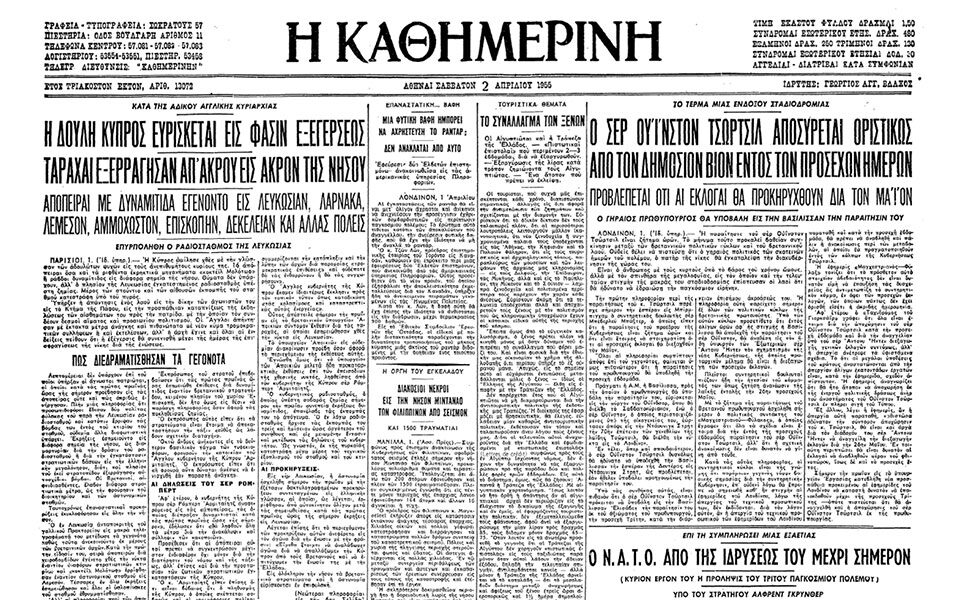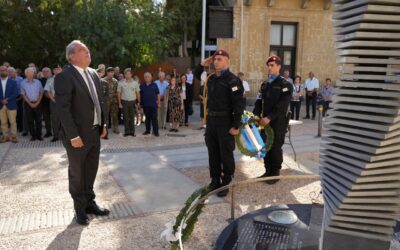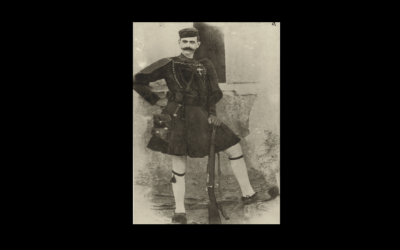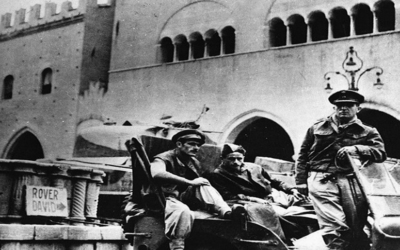The Minister of Defence of the Republic of Cyprus, Mr. Vassilis Palmas, attended the annual commemoration of the fallen of the 3rd…

It felt like an April fool’s joke. Who could have ever imagined that a handful of Greek-Cypriots would be rising up against the once colonial empire?
It was April 1, 1955, when the Greek-Cypriots rose up against British rule, aiming to, as was proclaimed at the time, “unite” with the motherland Greece.
Their struggle ended with the “London-Zurich Agreements” (February 19, 1959) whereby Cyprus was declared an independent state. And since then, following numerous mistakes, betrayals, disputes, a civil war, a coup, junta, and the invasion of Turkey, Cyprus is still divided in two with its capital, Nicosia, remaining, for almost half a century now, the only divided capital on the planet.
Half an hour after midnight on the 1st of April 1955, deafening noises, explosions, and bombings at power stations and police stations as well as at the Cyprus Radio Institution (RIK) haunted all the cities of the island and constituted the unfulfilled starting point of the struggle for Cyprus’ union with Greece.
Also read: Augustis Efstathiou | Afxentiou’s comrade passed away
The first proclamation of EOKA was released the same night and “Digenis” was the military leader of the organization.
The liberation struggle of EOKA was quickly embraced by the entire Cypriot people. Men, women, and children, each in their own way, left their mark in this unequal struggle. The superiority of the English was evident, whereas the poor armament of the Cypriots and their inexperience in the art of war were not able to break it. On the contrary, Cypriots’ perseverance and longing for freedom gave them courage and drive.
During the struggle, Britain took a hard line with military operations and executions. The first to be executed, on May 10, 1956, were Michalakis Karaolis and Andreas Dimitriou. They were hanged and buried in the so-called “Imprisoned Graves” in Nicosia.
Others followed until 13 fighters were buried in the “Imprisoned Graves”, among them Grigoris Afxentiou, who was killed on March 3, 1957, in a hiding place at the Monastery of Machairas.
Despite the bloodshed and the fighters who sacrificed their lives, the goal of the “Union” was not achieved. Following the London and Zurich agreements (February 19, 1959) Cyprus was declared an independent state on October 1, 1960.
Also read: The Cypriot Uprising of October 1931 against the British
READ MORE
120 years since the death of Pavlos Melas—The Hero of the Macedonian Struggle—Photos
The Armed Forces honor the memory of the ethnic martyr who gave his life for the liberation of Macedonia…
80 years since the Battle of Rimini – The Brigade that wrote golden pages of history
The “Rimini Brigade” wrote new pages of history for Greece, placing it in the camp of the winners. This success was linked to hope and…
Greece | PDPA’s “yes” to Placing Police Cameras on the Streets
The Personal Data Protection Authority gave the green light to the Hellenic Police’s placement of cameras on the streets to prevent and…
MBDA | Modernising TAURUS Missiles for the Bundeswehr
The Bundeswehr and TAURUS Systems GmbH (a joint venture between MBDA and SAAB) have signed a contract for the maintenance and…
Syria | New Minister of Defence Murhaf Abu Kasra
Syria’s new leaders have appointed Murhaf Abu Kasra, a prominent figure among rebels who ousted Bashar al-Assad, as…
Turkey – Spain | Memorandum of Cooperation for the Development of Turkish Hurjet Training Aircraft
Turkey and Spain have signed a Memorandum of Understanding (MoU) to develop Turkish-made Hurjet trainer-light fighter aircraft.
Red Sea | A US Fighter Jet was Shot Down by Friendly Fire
A US fighter jet was shot down by friendly fire over the Red Sea on Sunday, as announced by the headquarters of the US armed…
Northrop Grumman | Winner of the US Navy’s Next E-130J Aircraft Development Program
Northrop Grumman won the $3.5 billion contract for the US Navy’s E-130J nuclear command, control, and communications (NC3)…






















